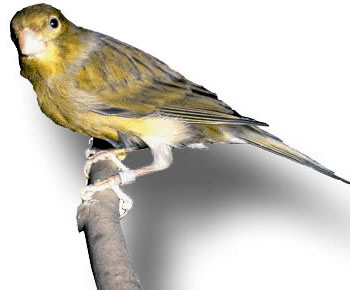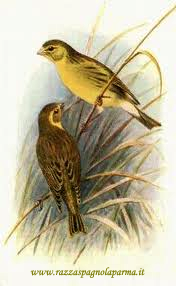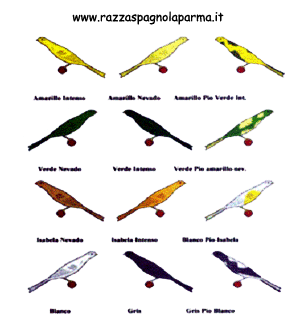Canaries Spanish Breed
 The Canary Spanish Breed descends directly from the
Canary Wild which refers to the size, hardness, vivacity prolificacy.
In 1931, a group of farmes of the Spanish company,
La Unión de Canaricultores de Barcelona, decided
to create a new breed, other than those who were present at that time,
a thin little bird, a miniature figure.
The farmers wanted to get a canary with the structure
of the body is very thin and with a size that it was between 11 cm
and 12 cm, (the smallest of all the canaries, the wild
canary is 13 cm). The first standard is 1931 but was
only approved on November 8, 1948 in Madrid the fourth national
congress of poultry.
The Canary Spanish Breed descends directly from the
Canary Wild which refers to the size, hardness, vivacity prolificacy.
In 1931, a group of farmes of the Spanish company,
La Unión de Canaricultores de Barcelona, decided
to create a new breed, other than those who were present at that time,
a thin little bird, a miniature figure.
The farmers wanted to get a canary with the structure
of the body is very thin and with a size that it was between 11 cm
and 12 cm, (the smallest of all the canaries, the wild
canary is 13 cm). The first standard is 1931 but was
only approved on November 8, 1948 in Madrid the fourth national
congress of poultry.
 The canaries of Spanish Breed are those that, in view of the breeds,
more approach the wild canary
(Canario of Mt. or Canario Silvestre, or Serinus Canarius Canarius).
In the Italian and Spanish Breed bred for about twenty years, despite its
selection in Spain has started several decades ago,
crossing the Canario Silvestre with timbrado.
This clarifies why we are faced with a canary rustic, lively and
much signing.
The canary of Spanish Breed is not over easy to breed than other races.
Many claim that the Spanish Canaries are excellent as nannies.
Evidently certain statements come from people or
few expert who never kept this species.
There were however be suckler excellent Spaniards
mestizos that turn out to be excellent imbeccatori also the
offspring of others.
The canaries of Spanish Breed are those that, in view of the breeds,
more approach the wild canary
(Canario of Mt. or Canario Silvestre, or Serinus Canarius Canarius).
In the Italian and Spanish Breed bred for about twenty years, despite its
selection in Spain has started several decades ago,
crossing the Canario Silvestre with timbrado.
This clarifies why we are faced with a canary rustic, lively and
much signing.
The canary of Spanish Breed is not over easy to breed than other races.
Many claim that the Spanish Canaries are excellent as nannies.
Evidently certain statements come from people or
few expert who never kept this species.
There were however be suckler excellent Spaniards
mestizos that turn out to be excellent imbeccatori also the
offspring of others.
 The canary of Spanish Breed is not over easy to breed than
other races.
It's very territorial, different, fiery and signing.
At the first cove you have to separate the male breeding
and to entrust the hatching and breeding only to females,
which otherwise with the signing or the numerous attempts to pair,
would be continually disturbed by the first up to
condition them with negative effects on offspring.
Females when observed while imbeccano offspring, also
from same breeder, often get stuck on the edge of the nest and
cease to feed the children. Merely set intrusive observer.
The canary of Spanish Breed is not over easy to breed than
other races.
It's very territorial, different, fiery and signing.
At the first cove you have to separate the male breeding
and to entrust the hatching and breeding only to females,
which otherwise with the signing or the numerous attempts to pair,
would be continually disturbed by the first up to
condition them with negative effects on offspring.
Females when observed while imbeccano offspring, also
from same breeder, often get stuck on the edge of the nest and
cease to feed the children. Merely set intrusive observer.
- Peculiarities of this breed is the small size.
- The length must be between 11 and 12,5 cm with a harmonious relationship between the various parts of the anatomy. Un canarino che supera i 13 cm e' considerato fuori standard e quindi eliminato durante rassegne. A canary that exceeds 13 cm is considered not-standard and then deleted during festivals.
- The BACK should be tight and so is the chest, but it mast not be a knife.
- The head should be small shaped hazel slightly flattened but not snake, with a small beak.
- The neck, should b fine and short and fall off sharply from the body in tune with all correspondence with the other constituent parts of the cuts.
- The wings have to be close to the body and long. Their tips do not have to cross but must fit together leaning on the the base of the tail giving the feeling of continue with it.
- The tail should not be too tight must end slightly forked but, very important, must be in line with it.
- The plumage must not have puffs nor with tie nor feathers falling to the sides, but should be short, medium thick and well-fitting. A repeating defect is the feather pecking in the back of the eye.
- For what concerns colors, the exhibitions are permitted Canaries Spaniards of all natural colors and are disqualified those artificially colored.
- The legs must be thin with short tarsus. Slender fingers, short and bearing small nail
- The canaries of Spanish Breed must bear the ring F.O.I. type A

 Italiano
Italiano Inglese
Inglese